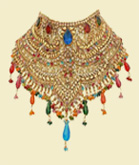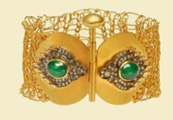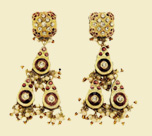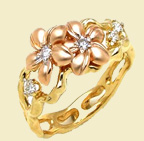TYPES OF INDIAN JEWELRY
Indian jewelleries are of different types. Jewelleries are being traditionally designed such as nose rings, earrings, bracelets, crowns, rings, anklets, amulets and necklaces, in any metal and styles are found in India. The range of jewellery in India varies from religious to purely aesthetic types. Jewellery is crafted not only for humans but also for the gods. Different regions of India have unique jewellery making styles. In Orissa and Andhra Pradesh fine filigree work in silver is found, in Jaipur the delicate art of enamelling or meenakari, the temple jewellery of Nagercoil and, Kundan or the setting of semi-precious or precious stones in gold from Delhi are now famous the world over.
The wide variety of silver beads found all over India, especially in Rajasthan, Gujarat, Madhya Pradesh and Himachal Pradesh are also well known. Indian Jewelleries are been made from variety of materials which include artistic pieces from Kundan, Resin, Glass, rice, plastic as well as shellac and an extensive list concludes. Amongst the Indian jewelleries the most unique antique Jewellery relates to the present trend and is in reality considered more of fancy jewellery. Antique jewellery is actually the modern day jewellery in gold or silver, which goes through a process of oxidising and is being sometimes buried in a pot of clay, to give it a dull look. Minakari Jewellery and Kundan styles of jewellery evolved from the influences of the Mughal dynasty.
Minakari is way of enamelling a unique combination of gems, enamel pigments Minakari Jewellery and precious stones and these are usually used in combination to make jewellery pieces that can be worn as chokers and necklaces. The motifs used in this art were flowers, plants, scrolling vines and animal forms, amongst others. At its simplest level, South Indian jewellery imitates forms found in nature. Chased gold is made to imitate the rudraksha bead sacred to the Lord Shiva; elements of necklaces may copy cut grass stalks, lotus buds, garlic bulbs or lentils as well as flowers. The naga ear ornaments are a mixture of formally arranged geometric elements, the squares grouped together at the front of the circular base, and a naturalistic cobra-hood, which develops, bizarrely, into a bat-like creature with fangs. This kind of jewellery is not easily accessible to those outside the culture that produces it. Apart from these few types, a whole range of the modern or contemporary jewellery is also found in India.

Indian jewellery is stylish and is not restricted only to a single metal. Manufacturers of gold jewellery use all materials, ranging from plastic and glass to white metal, cheaper alloys and fabric. India has been major manufacturer and exporter of jewellery in the recent years. Reshuffling and reversing the pages of history would lead us to the origin of the traditional Indian fashion jewellery. But the right point of start is still a mere blur.
The story of Indian fashion jewelry can be dated back to the Vedic era. The holy Ramayana and the Mahabharata had to replete with descriptions of ornaments worn by both men and women of that age. Infact even before the discovery of metals Indians are said to have adorned themselves with wooden jewelries and other materials which are easily available. The Harappa and Mohenjodaro civilization has the evidence of Indian fashion jewelry. By the 3rd century B.C. India became the leading exporter of gemstones, and that was a benchmark in the history of Indian jewelry.

During the ancient ages Indian Gods and Goddesses are crafted with rich and ornate temple jewelry, a trend still existent. Eventually those intricate filigree designs of Indian jewelry were being sported with by the women folk and it got absorbed into the bridal trousseau and worn on special occasions. The traditional Indian jewelry could be branched into three categories - spiritual, bridal wear and temple jewelry.
But with the flow of time all of them merged into one and took the form of Indian fashion jewelry. Indian fashion jewelry was given a royal patronage from the ancient times. But it reached its highest peak during the Mughal era. Men usually are the goldsmiths in India, traditionally, and a variety of names were given to them as per the region they belong to. Fashion jewelry in India is being made for almost every part of the body, ranging from the 'tika' for the forehead to the ring for the toe, a testimony to the love of jewelry and to the splendid skills of the Indian jewelers. In a broader aspect, jewelry in India was being handcrafted not only for humans but also for the ceremonial elephants and horses.
In the modern era Indian fashion jewelry is creating a new history for itself. Indian fashion jewelry is a rage among the recent generation and despite the tag of 'feminine' being attached to jewelry, both guys and gals are sporting with funky and traditional Indian jewelry. Be it the bold thumb rings or the sleek ear and nose rings, be it purely ethnic or purely funky Indian fashion jewelry is gearing its speed, expanding its domain at its best.

An important landmark in the history of Indian fashion jewelry is the expansion of the domain of raw materials used in its making. Besides gold and other metal jewelry, jute, beads, stones, conch shells, wood, plant seeds, etc are also used in the making of Indian fashion jewelry. These are setting a new trend in the modern fashion scenario befitting jewelries with the kind of attire you put on, be it funky or traditional.
Indian fashion jewelry is much more than just a tool of aesthetic appeal: rather it is a symbol of divine abundance and material blessings, tinged with fashion, updated with each passing day. A trend that started at the beginning of the civilization, may be at a more remote past, has been going strong till date and will definitely create new ripples in the near future with some more fusions, bifurcations, improvisations and new imaginations a new history of Indian fashion jewellery on the making.


